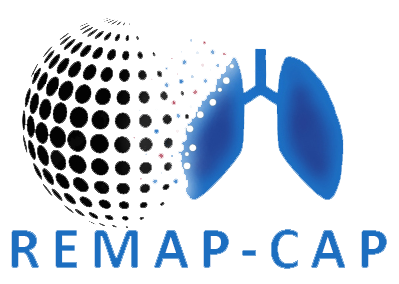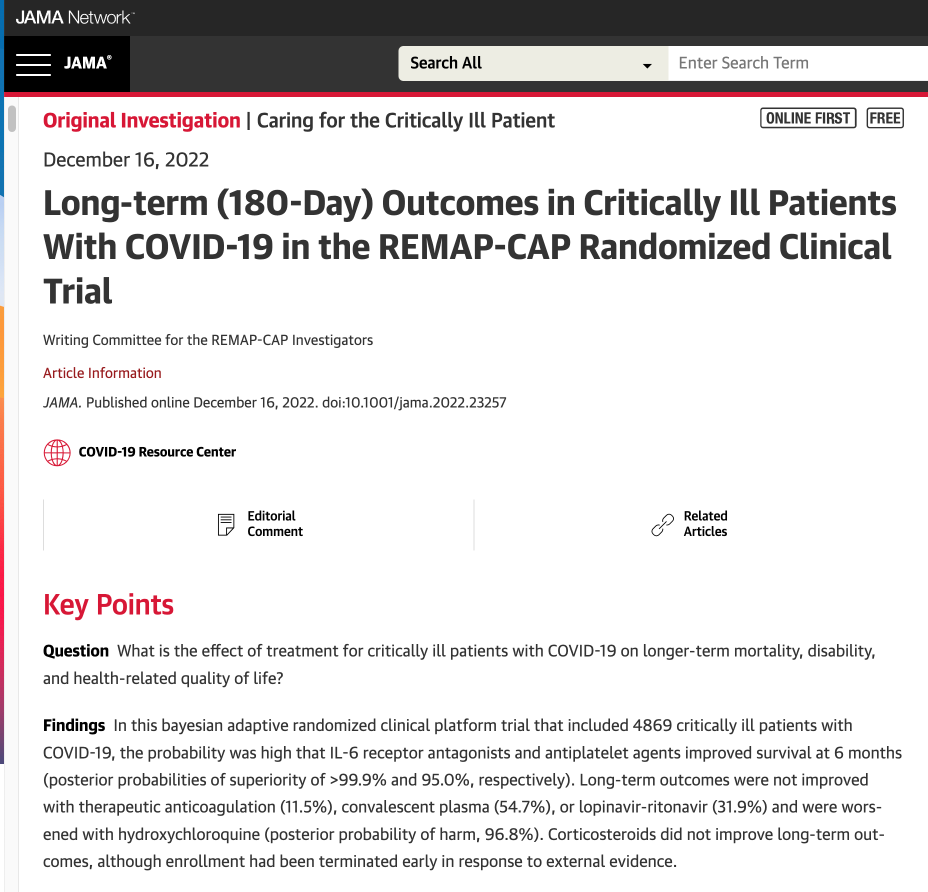Importance The longer-term effects of therapies for the treatment of critically ill patients with COVID-19 are unknown.
Objective To determine the effect of multiple interventions for critically ill adults with COVID-19 on longer-term outcomes.
Design, Setting, and Participants Prespecified secondary analysis of an ongoing adaptive platform trial (REMAP-CAP) testing interventions within multiple therapeutic domains in which 4869 critically ill adult patients with COVID-19 were enrolled between March 9, 2020, and June 22, 2021, from 197 sites in 14 countries. The final 180-day follow-up was completed on March 2, 2022.
Interventions Patients were randomized to receive 1 or more interventions within 6 treatment domains: immune modulators (n = 2274), convalescent plasma (n = 2011), antiplatelet therapy (n = 1557), anticoagulation (n = 1033), antivirals (n = 726), and corticosteroids (n = 401).
Main outcomes and Measures The main outcome was survival through day 180, analyzed using a bayesian piecewise exponential model. A hazard ratio (HR) less than 1 represented improved survival (superiority), while an HR greater than 1 represented worsened survival (harm); futility was represented by a relative improvement less than 20% in outcome, shown by an HR greater than 0.83.
Results Among 4869 randomized patients (mean age, 59.3 years; 1537 [32.1%] women), 4107 (84.3%) had known vital status and 2590 (63.1%) were alive at day 180. IL-6 receptor antagonists had a greater than 99.9% probability of improving 6-month survival (adjusted HR, 0.74 [95% credible interval {CrI}, 0.61-0.90]) and antiplatelet agents had a 95% probability of improving 6-month survival (adjusted HR, 0.85 [95% CrI, 0.71-1.03]) compared with the control, while the probability of trial-defined statistical futility (HR >0.83) was high for therapeutic anticoagulation (99.9%; HR, 1.13 [95% CrI, 0.93-1.42]), convalescent plasma (99.2%; HR, 0.99 [95% CrI, 0.86-1.14]), and lopinavir-ritonavir (96.6%; HR, 1.06 [95% CrI, 0.82-1.38]) and the probabilities of harm from hydroxychloroquine (96.9%; HR, 1.51 [95% CrI, 0.98-2.29]) and the combination of lopinavir-ritonavir and hydroxychloroquine (96.8%; HR, 1.61 [95% CrI, 0.97-2.67]) were high. The corticosteroid domain was stopped early prior to reaching a predefined statistical trigger; there was a 57.1% to 61.6% probability of improving 6-month survival across varying hydrocortisone dosing strategies.
Conclusions and Relevance Among critically ill patients with COVID-19 randomized to receive 1 or more therapeutic interventions, treatment with an IL-6 receptor antagonist had a greater than 99.9% probability of improved 180-day mortality compared with patients randomized to the control, and treatment with an antiplatelet had a 95.0% probability of improved 180-day mortality compared with patients randomized to the control. Overall, when considered with previously reported short-term results, the findings indicate that initial in-hospital treatment effects were consistent for most therapies through 6 months.







